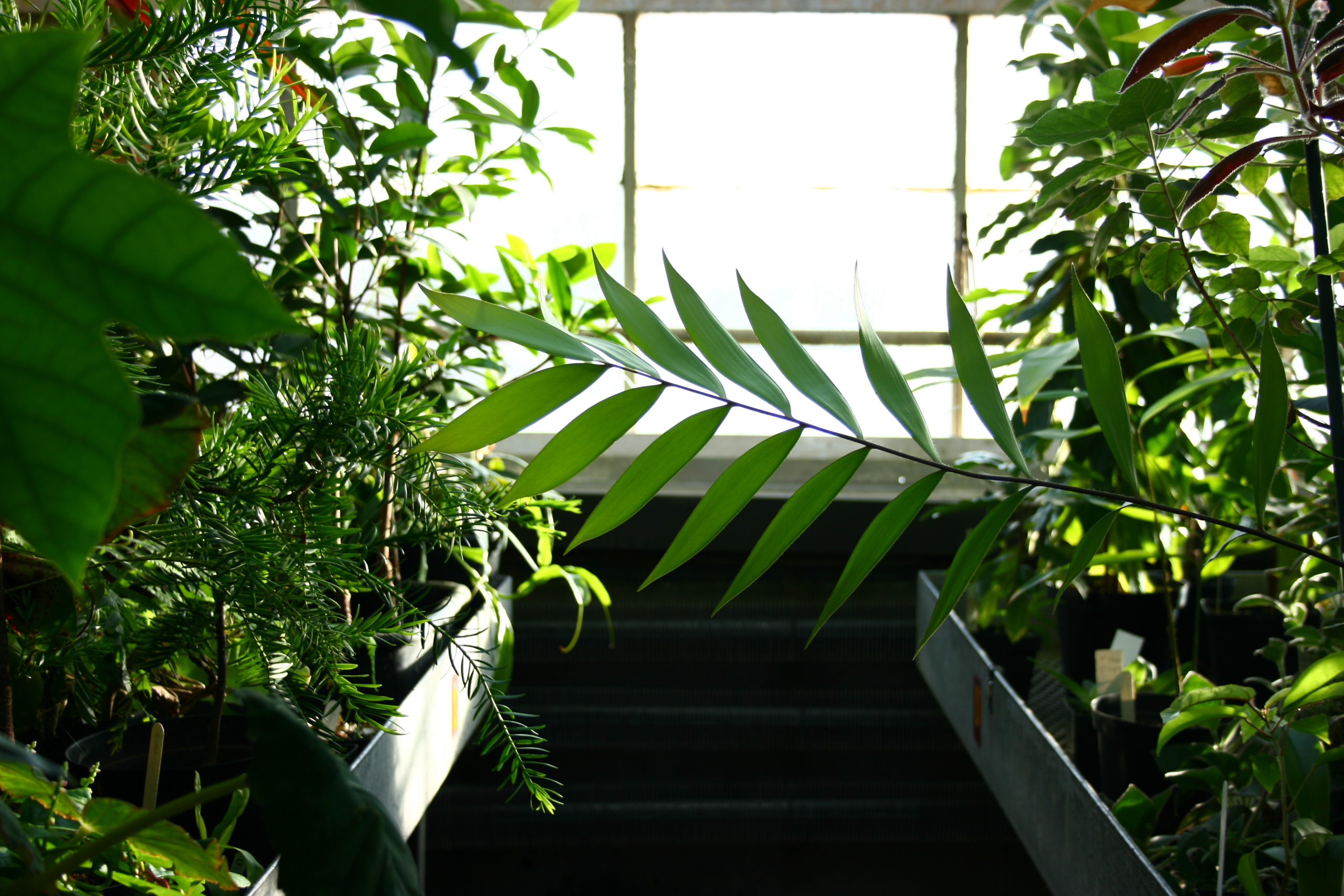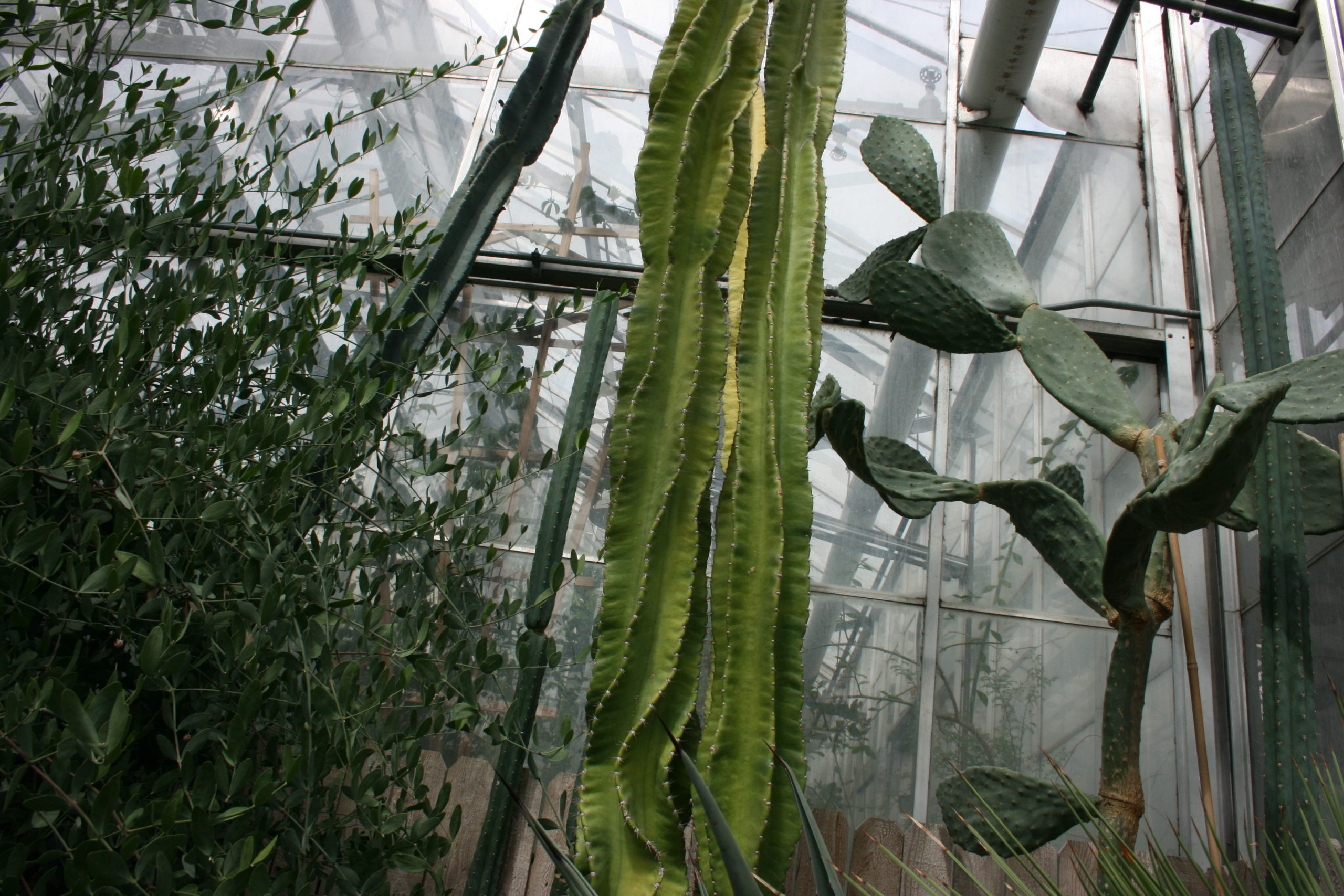The Green Behind the Glass: Collecting and Protecting Plants from Around the World
Guest editor Regan Golden interviews Lisa Philander, the Director and Curator of the University of Minnesota College of Biological Sciences Conservatory, about the intersection of curatorial practice and biology, the shifting cultural awareness of plants, and the strategies she uses for boosting the visibility of plants and educating the public to inspire conservation efforts.

introductionOn a snowy afternoon in late February, two glass buildings flush with green plants rise out of the flat white fields that mark the edge of the University of Minnesota’s Agricultural Campus in Saint Paul. Unlike the ornate domes at The Como Conservatory, the primary purpose of the College of Biological Sciences Conservatory is to function as a laboratory for plant biologists: fans whir loudly while carefully labeled plants flit in the artificial breeze bathed in light from grow lamps. The plants are displayed on simple metal shelves, but each tells a complex story about evolution, conservation and the perils of plant life in 2019. For some of the plants, the CBS Conservatory is the last stop on a path towards extinction; for other plants, it is a chance to start again. I interviewed the curator Lisa Philander just before the Conservatory moves to a new building in May: the current greenhouses will be demolished over the summer.
Regan GoldenThrough your work as a curator at the College of Biological Sciences Conservatory, how do get your visitors to see plants?
Lisa PhilanderI like to surprise people with the amazing qualities that plants have, like the leaves on the sensitive plants that close when you touch them, or the Trichoceros antennifer, an orchid bloom that mimics the look of a tiny fly. I like the surprise angle the best, trying to get people to see plants in a less mundane way. How can you look at a weed in a different way rather than just walking over it? It is an organism and has adapted specific strategies to be able to survive in that environment.
rgThis is a question I confront as an artist too: How can I make images where plants are more than just part of a background, as a small part of a larger landscape? What do you do at the Conservatory to foreground plants?
lpPlants are both beautiful and complex, but they don’t often demand our attention. One of the goals of the Conservatory is to combat “plant blindness,” which is the idea that plants are simply background information, when they are actually the basis for life on earth. We all need plants to live; all life on earth depends upon plants. As humans, our medicines are derived from plant compounds, our clothes are made of plants, we drink plants, we eat plants every day. Plants are critical for the planet’s survival as the ultimate building blocks of life.
And they are beautiful—the more you look at plants, the more your eyes open. Whether it is at a cellular, organismal or ecosystem level, they are undeniably amazing. I thought my interest in plants as a scientist would fade, but I am still finding new information or avenues of interest regarding plants. Right now, I am researching ferns, which may be some of the most frequently overlooked plants, even though many are used medicinally and some are edible.
rgWhy do you think plants are so important culturally right now?
lpPeople are becoming more aware of what they eat and where their food comes from, through a renewed interest in local food. This awareness leads people to be attuned to what plants grow in their backyard, or even in our state.
There is also a more holistic approach to health care emerging that centers on the use of plant-based medicines, and revolves around providing people with medicines that have fewer side effects or secondary interactions with other drugs.
At the same time, our environment also impacts our physical and mental health. There is a movement right now with architecture and landscape architecture to return plants to cities by creating indoor green houses and green walls. Plants improve air quality, but also help people to be calmer, more focused and more productive.
It is this trio of concerns about where people live and work, combined with how we care for ourselves, that has led to a new focus on the role that plants can play in our lives. Plants can be healing or ameliorating.

RGIs the study of plants becoming more predominant in the scientific community?
LPI don’t think so—plants have always been studied. In fact, when women first began attending universities, it was one of the areas deemed suitable for study. Maybe it’s becoming a larger interest for the public as climate change become as regular topic of discussion.
RGI also think about the role that women have played in the intersection of art and botany. For instance, Anna Atkins’ cyanotypes from the mid-1800s are just now being recognized for their contribution to both the development of abstract photography and the study of algae. I feel like the line between art and science has always been a little bit blurry when it comes to plants.
LPThe scientific training for botanists begins with drawing plants.
RGYour practice as a curator is quite broad: You are curating the plants in the collection, as well as curating art exhibitions and commissioning public artworks related to the plants in the conservatory. How do you see as your role as a curator?
LPIt is my job as curator to instill the love of plants in others, and this brings me back to plant blindness. If you show humans plants, seen as individuals with unique characteristics, there is a chance of convincing them of their importance. My background focused on medicinal plants, and when people realize how plants have saved lives, it is more likely that they will become concerned with their conservation.
RGWhen you are curating plants at the Conservatory, you are often trying to show relationships between plants that grow in very different parts of the world. Is that the focus of your work as a curator?
LPThe focus of my work here is to educate people about plants, and again, through this education, to promote conservation. It surprises people that even though plants evolve in different parts of the world, they might have a similar structure or purpose. It is important to tie the plants in our collection to the places that they are from, because many of these habitats are under threat and need conservation. The new conservatory we are building will be dedicated to plants from the Southern Hemisphere, where there is spectacular plant diversity, but limited funds for conservation. We bring these plants to Minnesota so that people can learn about the conservation challenges that other parts of the globe are facing.
RGWhat about protecting prairie plants in Minnesota?
LPPrairie restoration is an important part of the conservation effort in Minnesota, but there are places in the world that have really amazing plants that most of us will never see, and will most likely disappear if the world doesn’t take action to find a sustainable way to protect these places.
Also, I think it is important to educate people about the rare, more uncommon ecosystems or biomes. For instance, Cape Town in South Africa is a really unique ecosystem where two oceans meet at a mountain range, and it has incredible plant diversity, but also has amazing cultural diversity within the people and languages that are spoken there.

RGSo you look for places where there is a dynamic relationship between plants, people, and ecosystems?
LPYes, bio-cultural diversity hotspots are places that are a locus for human culture and biodiversity.
RGWhat do you think is most important for artists to know about our landscape or our environment in Minnesota? What do you wish that artists knew about the plants here?
LPWe all are recognizing that the climate in Minnesota is changing. How can we adapt as a result? How can we become more aware of conservation practices? Climate has changed throughout human history, as have human and plant relationships, but the latter are largely guided by culture. What is important or valued changes through time, space and who is using it. I’ve been thinking a great deal about the relationship between people, plants and place. How can we use plants to draw upon similarities of culture, as well as to acknowledge historical tragedies?
RGIs expanding the knowledge around Minnesota plants a way to educate people about the fact that this land was forcibly taken from the Dakota?
LPI am thinking a lot about how to educate people about the history of this landscape through an upcoming exhibition I am curating called Regeneration, that looks at the role that plants can play in healing intergenerational trauma. Focusing on the symbolism of plant growth, how do you transform trauma? I can’t help but think that planting is the first step in healing, a way of beginning again, releasing the old and creating the new.
RG I was really inspired by Laura Hall’s essay “My Mother’s Garden” in Art in Anthropocene that describes how planting her mother’s garden was one way of resisting colonialism and became a site for healing. Hall’s garden is a place for replanting the roots of her family that had been ripped apart through three generations of forced separation through Canada’s “reintegration” policy.
LPOn a personal level, I find the physical challenge of gardening really helps me release brooding thoughts. It’s the theme I am working on: how burying things with plants helps transform into life.
RG Unlike making art, which centers so much around vision, gardening is definitely an embodied experience for me. It engages all my senses and focuses my attention.
LPSeveral parts of the world have healing groves of trees. Whether is a garden or a forest walk, I think having a physical space to direct our feelings at sometimes is helpful. The tree can handle it!
RG I think that color and light, what we think of as the formal qualities of a garden or even a photograph of a garden, can also be calming.
As a scientist, what do you enjoy about working with artists?
LP I feel challenged by the artists I work with to see plants from different perspectives, and to confront the challenges we face at the CBS Conservatory with a fresh vantage point about how to make plants more visible.

This article is part of the series Seeing Plants: Vision and Botany in Contemporary Art, guest edited by Regan Golden.